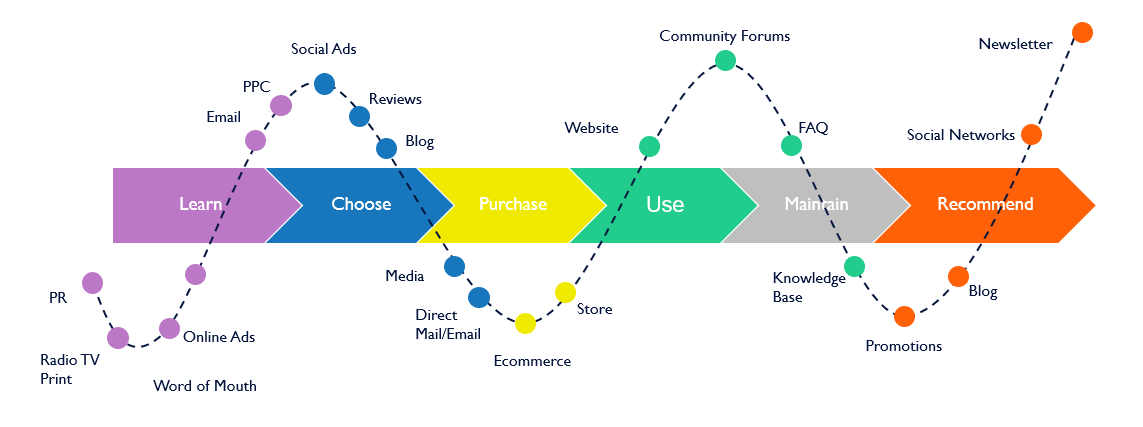The customer journey and the customer lifecycle are terms that are often used interchangeably, but there are nuances that make them different. The customer journey is really about the customer's point of view and perspective in terms of how they interact with the organization. The customer lifecycle on the other hand looks at the customer from the organization's perspective. From that perspective, the relevant issues are the systems and processes that support the customer journey and how they can be measured. Both perspectives are valuable in understanding the customer experience and providing insights into both customer behavior and business outcomes.

Why track metrics?
KPIs provide the data that organizations need in order to assess their performance, and in particular, those relating to the customer journey provide a window into critical elements of your business:
What attracts customers to your organization, how they search for products and services, what convinces them to buy, and what motivates them to return.
A lot of organizations say they want to be data driven with respect to decisions that affect the customer experience, but they don't necessarily have the pieces in place for that. When they look at building the correct metrics and having mechanism to act on those metrics, they can identify and quantify the impact of problems. The goal is to show which issues are impacting a metric that reflects an operational piece. What’s going to get people’s attention is to be able to describe the outcomes in data terms. It also becomes possible to measure and manage remediations, to make sure that the course corrections, in fact, are correct.
One of the unintended consequences of changes in strategy is that there may be a dependency that makes one change adversely affect another process. For example, a simplified taxonomy might help people find top tier products more quickly but make it harder to find specific product parts. This might be a good thing if the top tier products are high value but might lose entry level customers. However, when the right metrics are in place, it’s possible to look holistically at all the factors to be sure that interventions are having the expected effect on the customer experience.
Beyond improving customer satisfaction, a major reason for obtaining KPIs is that organizations need to make sure that their investments in technology, tools, and processes are justified, whether it’s an initial investment or an ongoing one. Often, justifying data projects is difficult, but when there is a clear linkage made between the investment and a positive outcome such as an increase in top line sales, cost reduction or customer retention, getting the all-important executive support becomes more feasible. It may not be possible to prove, but correlations between a better customer experience and a better business outcome can be convincing
Which metrics are the right ones?
Customer Behavior Metrics
The idea behind this set of metrics is to see what your customer are doing on your site. Is the customer experience seamless and pleasant, or disrupted and frustrating? Search and navigation are among the top customer-facing metrics—how do customers locate products and services? How many clicks does it take to find what they want; are they saving things, are they frequently searching for the same things and not finding them? How long does it take to establish customer, engagement and conversion?
Bounce rate and dwell time are two popular metrics for inferring whether the customer experience is going well. Bounce rate is the percent of visitors who leave a website after visiting just one page on the site without engaging. There could be multiple causes of a high bounce rate, and trying to understand all of the reasons could be a challenge. Nevertheless, it’s important to ask why. Dwell time, another metric of user behavior, measures a visitor’s interest in a particular page. Longer dwell times indicate greater interest in the information on that page.
When visitors navigate through the website but do not remain on the page, there are multiple possible reasons why. Was the taxonomy not helpful in getting them to the right place? Or were the keywords not helpful in finding the right content? Finding the root causes of a metric can be difficult but it's important to look into those causes to get a better understanding. In order to put the customer experience in context you need to know what happened before they landed on that page and what happened after.
Sometimes metrics are more revealing in combination, for example. If the visitor is bouncing in and out multiple times, especially in an engagement scenario, you need to measure the visits together--timing is important. If you check to see the number of downloads and what are they finding interesting, it may be that you need more of that type of content on your site to engage them further. It’s also important to look across channels. Maybe they found what they wanted and bounced out to call a sales rep and order it from a call center. Achieving a holistic view of the customer experience is important; a set of disparate data points is much less helpful.
Customer Sentiment Metrics
Another important metric is voice of the customer feedback. Information is collected about the message out in the marketplace about the brand’s reputation, its corporate responsibility, and other factors that affect perception about the company. Another tier of comments relate to the products; are they reliable and easy to use, for example, and do people feel the pricing is competitive and the billing process is clear. From the unstructured data, entities are extracted and then classified, and comments may also be rated as to whether they rate the customer experience at each stage as positive, negative, or neutral.
You can then run analytics on this data, and extract a lot of details. Customer sentiment is subjective, but if you are measuring it consistently to get a baseline, it will help you measure every stage very objectively, because your get your extracting it, even though customer experience is subjective, if you are measuring it consistently you're getting analytics that you can then use as a baseline.
Metadata for products, customers, and rules
In order for customers to find products when they search, product data has to be clear, appropriate, and complete. If product data quality is poor, then the products will be invisible to searchers, or they will find the wrong products. If they can’t find the right product they won’t be making a purchase on that visit. If the customer experience is bad enough, they might not even return to the site in the future.
Metadata about the customer is as important as product metadata. How do we describe the customer so we're capturing this information? We need to build a metadata model for the customer—are they a professional, consumer, bargain hunter, free spender? Then there are segments such their industry or sector. Customers throw off a lot of “data exhaust,” and if you are not capturing it and making sense of it, you are losing a lot of insights.
When you write rules for the dimensions of your metrics, start with completeness and then expand from there. You want to make sure you understand all of the dimensions of your data and you can get into more granularity about the different dimension. Metadata is important for rules because you want to rules should be reviewed periodically. To do this, it’s necessary to know who owns them, what tools they belong to, information about the data provenance and administrative metadata.
Many tools are not fully utilized because maybe they don't have the adequate high quality data. As organizations explore how to improve their KPIs, they are likely to conclude that their data quality needs improvement too. So in addition to providing insights into customer behavior and the overall customer experience, the decision to implement a comprehensive plan to obtain customer journey metrics can also help organizations make better use of their technology investments by launching an initiative to improve data quality.
Ready to get started with data driven decision-making? Contact us today!

